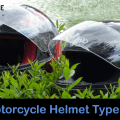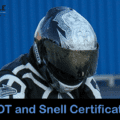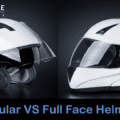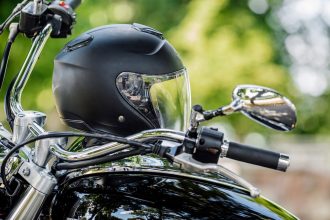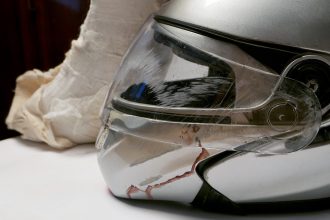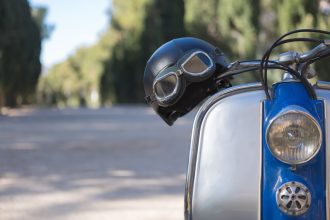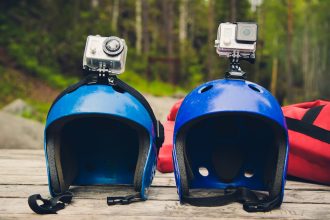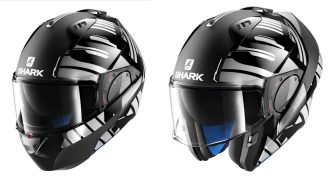Many riders are unsure of how to strap a motorcycle helmet properly, especially if it features a D-ring buckle.
Some fasten it the wrong way, while others just give up and choose not to use it altogether.
This creates a very dangerous situation on the road, not only for the rider but also for those on the same road as him.
How To Strap a Motorcycle Helmet
No matter how well-built your helmet is, it won’t work as designed if you don’t wear it properly.
It won’t absorb enough of the impact, or worse, become undone, leaving you with no protection at the worst possible moment.
We’re here to help keep you safe with the following tips on how to strap your helmet.
There are three common motorcycle helmet straps: the double D-ring, quick release, and micrometric.
Quick-Release Buckles
Quick-release straps work the same way that seatbelts do.
One part of the buckle looks like a flat metal with a hole. It is attached to a strap on one side of the helmet.
A spring-operated catch is attached to a strap on the other side.
Once you put the helmet on, simply link the two parts beneath your chin. The mechanism inside them will automatically lock the buckle.
You can use loosen or tighten the strap using the length adjuster.
A push button also releases the buckle if you need to take the helmet off.
The quick-release strap is quite easy to figure out. It is also very easy to operate, except maybe if you are wearing gloves.
Micrometric Buckles
A micrometric helmet buckle works like a big reusable cable tie. Its locking mechanism consists of two parts.
One is a toothed component attached to a strap on one side of the helmet. The other is a ratchet attached to a strap on the other side.
If you insert the toothed part to the ratchet, a mechanism inside the ratchet holds on to the grooves or teeth.
The interlocking of the two parts provides the security that keeps your helmet in place.
If you want to take off your helmet, simply pull the tab on the ratchet to release the toothed part.
Compared to quick-release buckles, the micrometer is very easy to operate, even if you are wearing gloves.
Double D-Ring Buckles
The double D-ring is the most common type of motorcycle strap mechanism.
It is probably the oldest strapping mechanism for motorcycle helmets. Experienced riders also feel that it offers the most security.
As the name suggests, it consists of two D-shaped rings attached to a strap on one side.
There is a locking strap on the other side of the helmet.
With this type of strap, your helmet has the smallest chance of coming loose.
While it looks simple enough, it is actually a bit complicated if you do not know the specific steps.
Most motorists, especially those new to riding, have trouble working it.
If you are one of them, don’t worry. We have outlined the whole process for you.
Step 1: Put the Helmet On
Place your motorcycle helmet over your head and ensure that your vision is not obstructed.
It must fit comfortably—not too loose and not too tight.
If your helmet is too loose, it will increase the risk of injury in case of an accident.
If it is too tight, it can press too much on your cheeks and cause discomfort. This could distract you while driving and make you more susceptible to mishaps.
To ensure a great fit, you must choose the right helmet size before purchasing.
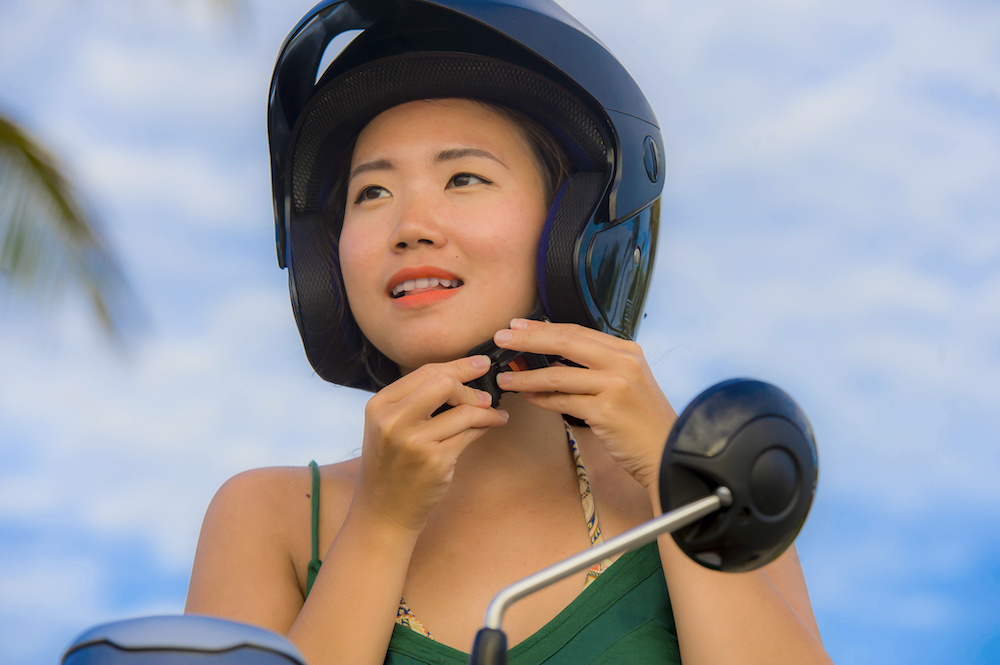
Step 2: Strap the Buckle
In most helmets, the D-ring buckle is on the left side, while the right strap has a snap button.
Start by taking the snap button strap and looping it through both D-rings.
Next, split the D-rings apart with one finger, creating a space where you can loop the snap button strap back.
Then, take the end of the strap and insert it into the outer D-ring.
When we say outer ring, it is the one closer to the opposite side of the D-ring buckle.
Step 3: Adjust the Strap Until It Fits Comfortably
Finally, pull the strap until you achieve a good fit.
This part is important because it will mean the difference between comfort and choking or skin irritation and your safety.
The general rule is that you must be able to fit two fingers between the strap and the chin.
Once you feel confident about the fit, secure the loose end of the strap using the snap button.
Remember that while you are strapping your helmet on, you won’t be able to see the buckle or the strap.
Most of the time, you will rely on how everything feels with your fingers.
It might sound a bit difficult, and it can be challenging at first. Nevertheless, you can get it done properly and consistently in no time with some practice.
One trick is not completely removing the strap from the buckle when taking off your helmet.
Just loosen it until you can slide the helmet off your head, along with the looped strap.
When you put it on again, move the strap out of the way so that it won’t get caught on your face.
Once your helmet is on, simply position the strap under your chin and adjust its tightness.
Why Proper Wearing of Helmet Is Important
We have already mentioned in passing why you should wear your helmet properly while riding.
However, it is such a very important part of motorcycle safety that it bears mentioning again and in deeper detail.
Among all the motorists on the road, motorcycle riders stand to benefit the most from wearing protective headgear.
That is because they are exposed to a higher risk of crashing than car drivers.
For instance, a slippery road, loose gravel, and even potholes can cause you to lose balance.
If you get into an accident while riding your motorcycle, the most vulnerable part of your body is your head.
Your helmet is your first and only defense against injuries in this area.
That said, the effectiveness of your helmet in protecting you rests not only on its inherent qualities but on how you wear it.
If you fail to secure it properly, it can wobble or fall off upon impact, preventing it from protecting your head.
Other Motorcycle Helmet Safety Tips
As a road user, it is important for you to know how to strap a motorcycle helmet.
More than that, there are many other things that you must pay attention to for a safe riding experience.
Here are a few more tips regarding motorcycle helmets:
Chin Strap Maintenance
When wearing your helmet, the D-rings on its strap can come into contact with your chin. So, aside from the environment, it is exposed to your sweat.
Over time, it will corrode and even rust. These corrosions can irritate your skin, especially if you are sensitive to them.
Also, they could damage the strap and compromise the integrity of your helmet.
To prevent this from happening, regularly apply a layer of grease on the metal parts of the strap.
Choosing the Right Helmet Quality
Every rider should be vigilant at all times and look for the safest helmets currently available.
This technology is constantly evolving, which means its design is always improving.
It’s also the reason why experts recommend that you replace your helmet every five years, even if it wasn’t in an accident.
If you are in the market for a new protective headgear, make sure to purchase only from reputable vendors.
Check that the shell is made from carbon fiber or high-resistance thermoplastic, the most commonly used helmet material today.
Also, look for a certification from the Department of Transportation or DOT.
Proper Helmet Size
Aside from the quality of the helmet, you must also consider its size carefully.
As mentioned, if your helmet doesn’t fit you comfortably, it won’t be able to absorb enough impact.
If you get into an accident, you could end up with severe injuries even if you are wearing it.
As much as possible, avoid buying a helmet online unless you have tried it on before.
If you can’t help it, make sure that the supplier has a good return policy. This way, it’s easy to replace if the helmet you ordered does not fit you right.
Ensuring Road Safety
It is hard to imagine that something as simple as a strap could mean the difference between safety and injury.
Nevertheless, strapping your helmet on properly could help protect you in case of an accident.
Hopefully, with the tips we outlined, you will be safer the next time you hit the road.
We hope you find this information helpful. If you would like to support this site, you can by purchasing through recommended links on the page. Should you decide to purchase, we may earn a small percentage of the sale at no cost to you.
Thank you for your support.




